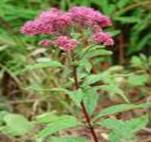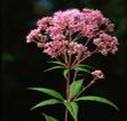Scientific Classification:
|
Other Common Names:
The other common names for the herb gravel root are Joe-pye weed, Gravel or kidney root, Trumpet weed, Purple or tall boneset,Gravelweed,Jopi Weed,Queen-of-the-Meadow Root,Eupatorium urpureum,Trifoliatum,Maculatum,Eupatorium verticillatum,Eupatorium ternifolium and Hempweed.History

Description

Range
Gravel root is a native of North America and are now distributed over an area extending from Canada to Florida. It also covers a wide range from South-eastern and Central N. America - Newfoundland to British Columbia to Washington and New York.
Habitat
Gravel root thrives best in damp meadows, moist woods and thickets, sides of streams and ditches. Thus it frequently establishes in marshes, wet meadows, swampy woods, roadside ditches, lakeshores, stream edges, bogs, and other wet places.
Cultivation
Gravel root is sometimes cultivated in wild gardens or herb gardens, as its flowers are extremely showy and it towers over surrounding plants. Succeeds in ordinary garden soil that is well-drained but moisture retentive in sun or part shade. Plants can be grown in quite coarse grass, which can be cut annually in the autumn. A very cold-hardy plant, tolerating temperatures down to about -25°c.The bruised leaves have a vanilla-like odour. Plants seem to be immune to the predations of rabbits. Butterflies are attracted to this plant. Sow the seed in spring in a cold frame and only just cover the seed. Prick out the seedlings into individual pots when they are large enough to handle and plant them out into their permanent positions in the summer. Division in spring or autumn. Very easy, the clumps can be replanted direct into their permanent positions. It should be thoroughly cleaned and dried slowly in a shady spot. When it is dry, it can be crushed or cut into pieces and stored in a cool, dark, dry place. It is made into a tea, decoction, or tincture; it yields its virtues both to water and to alcohol.Flowering Season
The purple tubular flowers of the gravel root are in bloom between August to September.Pests and Diseases
Weeds in the pots will have to be controlled manually and through good santitation practices. There are no pre- or postemergence herbicicdes of which Joe-Pye weed is specifically mentioned as being tolerant.
Parts Used
 |
The aerial parts, rhizome and the roots are the most commonly used parts of the plant for its medicinal and commercial purposes. |
Medicinal Applications


- It is used as a healing tonic included relieving constipation, washing wounds with a strong tea made from the root to prevent infection and as a general tonic taken during pregnancy and after childbirth.
- Its main use is to treat urinary infections and stones.
- Gravel root is considered a valuable remedy in dropsy, strangury, gravel, hematuria, gout and rheumatism, exerting a special influence upon chronic renal and cystic troubles.
- Gravel root is also useful for cystitis, urethritis, prostate enlargement (and other forms of obstruction), and for rheumatism and gout.
- The tea of this herb is used to induce sweating and break a high fever.
- Gravel root can be used to alleviate problems with cystitis.
- Laboratory studies indicate that the herb’s active ingredients may have anti-infective and cancer-fighting properties.
Commercial Applications
- The stems have been used as straws.
- The fruits yield a pink or red textile dye.
Folklore and Myths
There are more than forty species in this genus and many have medicinal uses; early American colonists used Joepyeweeds to treat various ailments and, according to folklore, an Indian called 'Joe Pye' used the plant to cure fevers.Joepyeweeds can grow up to 12 feet tall making them one of America's tallest herbs.' Sweet joepyeweed' was given its common name because if bruised, the foliage smells like vanilla. Gravel root used in herbal medicine to ease the passage of stones, is also alleged by root doctors to grant the bearer control over job situations and thus is an ingredient in formulas such as Steady Work and Boss Fix. Some people say that they mix this root with steady work powder and sprinkle it around the room where they will be interviewed for a job. Folklores tell that chips of gravel root can be brewed into a bath-tea or burned with incense while doing a job-getting or work-promotion candle-spell.

